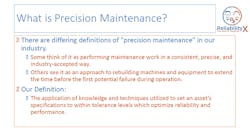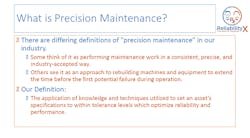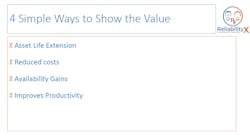How to use data to bridge the gap between maintenance and operations
Joe Anderson is partner and chief operating officer for ReliabilityX, helping companies reach their full potential through improvement gains and lowering costs and giving them competitive advantage on their journey to excellence. During the live Q&A portion of the webinar, "Precision Maintenance: Understanding the Quantifiable Value of Maintenance," Anderson tackled several attendee questions on the implementation of precision maintenance.
PS: How do you overcome pressure from operations to get their assets back up and running quickly?
JA: I spend time educating upper-level management first. If you want to drive any change, it starts there. When I want to get results on the floor, I'm out there working with technicians and teaching them things. If, for example, a lot of questions are swirling around OEE and the calculation-of-loss buckets, and you understand it better than they do, then it gives you the ability to educate them. It's about you being more educated on that topic than the other person that you're dealing with is. That gives you the opportunity to educate, coach and mentor them through it. And then I bring in data.
Here’s an example I'm sure a lot of you can relate to. If you walk into the 8:00am meeting and your maintenance manager says, "Well, we didn't hit our target because we had 30 minutes of downtime," then maintenance argues, "Well, it was only 30 minutes." The manager replies, "I don't care if it was 30 minutes," and it becomes a mess. But if you understand what the machine is designed to run and you know the number of hours that it was supposed to run, then you can see the full picture. For example, say a machine is designed to run 30 units per minute or 1,800 units per hour. If you know that the machine had six hours of run time, then that comes out to 10,800 units, which means 30 minutes of downtime cost you 600 units.
If production numbers don't reflect 10,200 units, if only 4,000 units are produced in that time, then you can say, "Okay, I will take responsibility for the 30 minutes of downtime. I'll do the best that I can and work to the best to my ability to make sure it doesn't happen again. But theoretically, we were supposed to do 10,200 units, even with the 30 minutes of downtime, and you guys only did 4,000. So where are the other 6,000 units?"
And that gets people to start asking questions. I don't think we go into these meetings prepared enough to ask those difficult questions. And when you ask those difficult questions, and you do it over and over at every meeting, you can start educating people.
You start getting them to ask those questions, and when you realize it's minor stops and speed losses, then you say, "Listen, what we've realized is that a majority of these losses are minor stops. I'm working on the maintenance stuff, but I would love to help you guys eliminate minor stops. The problem with minor stops is that operations is responsible for them. Will you allow me to help coach you guys through it so we can show you how to eliminate these issues?"
And all it takes is one supervisor or one operator to say, "I want your help.” It's going and getting quick wins and showing them results, not just putting blame and offering to help them. But again, you have to know more than they do about their own operation.
PS: How do you get operations to align on how you bucket downtime in the categories you talked about today?
JA: You have to be able to educate them on what the buckets are and put definitions behind them. For example, I told you that breakdowns are 10 minutes or more and require a part. Anything 10 minutes or more and doesn't require a part is a process failure. Those two losses sit in the availability bucket along with a third, and that's your setup and adjustments. Normally you're taught that it's setup adjustments and breakdowns. Process failures doesn't exist in the OEE calculation today when you look it up online. It exists in ours because we've added it.
Process failures occur more than people want to admit. Accidentally hitting the E-stop and not being able to pull it out and having to go reset a machine means you're calling in maintenance resources to do something that an operator should know how to do. That has nothing to do with maintenance. That's an operator issue.
Then you have your two losses in the performance bucket, which are speed losses and minor stop. A minor stop by definition is 10 minutes or less. Doesn't matter if you change parts or not, 10 minutes or less is a minor stop. If it can be changed in 10 minutes or less, it should be something that an operator should be able to do. For example, you have to change suction cups on a box machine because it's not pulling boxes. Operators should be able to change suction cups.
Box jams – how many times do you go out and see a machine down because either it's not set up properly or the core gets elongated or too short, or whatever, because there's no quality checks? That happens thousands of times a day, and none of that gets recorded on your downtime bucket. You'll have four hours of minor stops in an eight-hour shift, but that 90-minute breakdown will be blamed for everything that they've lost.
It's all about educating them on what these buckets are, putting definitions behind them and finding ways to capture the data.


